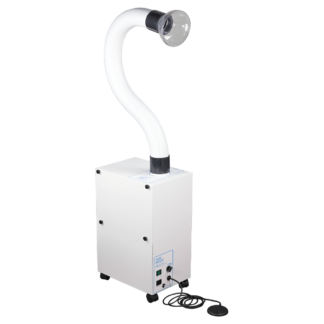
Vaniman Manufacturing Co. is proud to announce the arrival of our latest product for industrial customers: the Pure Breeze FX HEPA Fume Extractor.
The newest member of the Pure Breeze family of HEPA filter-based air cleaners includes our long-neck flexible capture hose for targeted fume extraction and a smaller body with foot pedal start/stop control. Portability, flexibility, and convenience come together in this must-have for industrial settings.
This new unit is specially designed for anyone whose work involves:
- Soldering
- Micro welding
- Laser welding
- Laser engraving
- Laser cutting
- Any benchtop process that creates harmful fumes or unpleasant odors
Like other products in the Pure Breeze line, the Pure Breeze FX has multiple stages of filtration. The HEPA filter captures 99.97% of all particulates down to 0.3 micron. The charcoal odor filter traps hazardous fumes and volatile organic compounds (see the long list of known compounds effected by this filter below).
This fume extractor rolls around on sturdy caster wheels and sits with a small footprint for maximum convenience in industrial settings. It can move from station to station with ease.
It also comes with Vaniman’s signature sound dampening foam to keep this unit whisper-quiet at only 54 dBA (compared to a normal human conversation which averages 60 dBA).
Filters are easily swapped out and all parts are easily replaced. Like all Vaniman products, this fume extractor is designed to last for a very long time.
You can order this portable fume extractor at our introductory pricing through our website, or, for international customers, you can contact us by email at sales@vaniman.com or by phone at +1.760.723.1498. Web orders in the contiguous United States will receive free shipping with this product.
If you need a quiet, moveable fume extractor that’s built for quality right here in the USA, shop Vaniman!
Adsorptive ability of charcoal odor filter by chemical compound:
(E = Excellent; G = Good; F = Fair; P = Poor)
Acetaldehyde: F
Acetic Acid: E
Acetic Anhydride: E
Acetone: G
Acetylene: P
Acrylic Acid: E
Acrylonitrile: E
Alcoholic Beverages: E
Amines: F
Ammonia: F
Amyl Acetate: E
Amyl Alcohol: E
Amyl Ether: E
Aniline: E
Asphalt Fumes: E
Automobile Exhaust: G
Benzene: E
Body Odors: E
Borane: G
Bromine: E
Burned Flesh: E
Burned Food: E
Butadiene: G
Butane: F
Butanone: E
Butyl Acetate: E
Butyl Alcohol: E
Butyl Cellosolve: E
Butyl Chloride: E
Butyl Ether: E
Butylene: F
Butyne: F
Butyraldehyde: G
Butyric Acid: E
Camphor: E
Caprylic Acid: E
Carbolic Acid: E
Carbon Disulfide: P
Carbon Dioxide: P
Carbon Monoxide: P
Carbon Tetrachloride: E
Cellosolve: E
Cellosolve Acetate: E
Cheese: E
Chlorine: G
Chlorobenzene: E
Chlorobutadiene: E
Chloroform: E
Chloronitropropane: E
Chloropicrin: E
Citrus and Other Fruits: E
Cleaning Compounds: E
Coal Smoke: G
Creosote: E
Cresol: E
Crotonaldehyde: E
Cyclohexane: E
Cyclohexanol: E
Cyclohexanone: E
Decane: E
Dibromoethane: E
Dichlorobenzene: E
Dichlorodifluoromethane: G
Dichloroethane: E
Dichloroethylene: E
Dichloroethyl Ether: E
Dichloromonofluoromethane: G
Dichloronitroethane: E
Dichloropropane: E
Dichlorotetrafluoroethane: E
Diesel Fumes: E
Diethylamine: G
Diethyl Ketone: E
Diethylaniline: E
Dimethyl Sulfate: E
Dioxane: E
Dipropyl Ketone: E
Ethane: P
Ether: G
Ethyl Acetate: E
Ethyl Acrylate: E
Ethyl Alcohol: E
Ethyl Amine: G
Ethyl Benzene: E
Ethyl Bromide: E
Ethyl Chloride: G
Ethyl Ether: G
Ethyl Formate: G
Ethyl Mercaptan: G
Ethyl Silicate: E
Ethylene: P
Ethylene Chlorohydrin: E
Ethylene Dichloride: E
Ethylene Oxide: G
Essential Oils: E
Eucalyptole: E
Fertilizer: E
Film Processing Odors: G
Fish Odors: E
Floral Scents: E
Fluorotrichloromethane: G
Formaldehyde: F
Formic Acid: G
Gangrene: E
Garlic: E
Gasoline: E
Heptane: E
Heptylene: E
Hexane: G
Hydrogen: P
Hydrogen Bromide: G
Hydrogen Chloride: F
Hydrogen Cyanide: G
Hydrogen Fluoride: F
Hydrogen Iodide: G
Hydrogen Selenide: F
Hydrogen Sulfide: G
Incense: E
Indole: E
Iodine: E
Iodoform: E
Irritants: E
Isophorone: E
Isopropyl Acetate: E
Isopropyl Alcohol: E
Isopropyl Ether: E
Kerosene: E
Kitchen Odors: E
Lactic Acid: E
Menthol: E
Mercaptans: E
Methane: P
Methyl Acetate: G
Methyl Acrylate: E
Methyl Alcohol: G
Methyl Bromide: G
Methyl Butyl Ketone: E
Methyl Chloride: G
Methyl Chloroform: E
Methyl Ether: G
Methyl Ether Ketone: E
Methyl Formate: G
Methyl Isobutyl Ketone: E
Methyl Mercaptan: E
Methylcyclohexane: E
Methylcyclohexanol: E
Methylcyclohexanone: E
Methylene Chloride: E
Monochlorobenzene: P
Monochloromonofluoromethane: E
Naphtha: E
Naphthalene: E
Nitric Acid: G
Nitrobenzene: E
Nitroethane: E
Nitrogen Dioxide: F
Nitroglycerine: E
Nitromethane: E
Nitrotoluene: E
Nonane: E
Octalene: E
Octane: E
Onions: E
Organic Chemicals: E
Ozone: E
Packing House Odors: E
Paint & Redecorating Odors: E
Palmitic Acid: E
Paradichlorobenzene: E
Pantane: G
Pentanone: E
Pentylene: G
Pentyne: G
Perchloroethylene: E
Perfumes, Cosmetics: E
Phenol: E
Phosgene: G
Pitch: E
Poison Gases: G
Pollen: G
Popcorn and Candy: E
Poultry Odors: E
Propane: F
Propionaldehyde: G
Propionic Acid: E
Propyl Acetate: E
Propyl Alcohol: E
Propyl Chloride: E
Propyl Ether: E
Propyl Mercaptan: E
Propylene: F
Propyne: F
Putrefying Substances: G
Putrescine: E
Pyridine: E
Resins: E
Rubber: E
Sauerkraut: E
Sewer Odors: E
Slaughtering Odors: G
Smog: E
Sour Milks: E
Stoddard Solvent: E
Styrene Monomer: E
Sulfur Dioxide: F
Sulfur Trioxide: G
Sulfuric Acid: E
Tetrachloroethane: E
Tetrachloroethylene: E
Tobacco Smoke Odor: E
Toilet Odors: E
Toluene: E
Toluidine: E
Trichloroethane: E
Trichloroethylene: E
Turpentine: E
Urea: F
Uric Acid: E
Valeraldehyde: E
Valeric Acid: E
Varnish Fumes: E
Xylene: E

